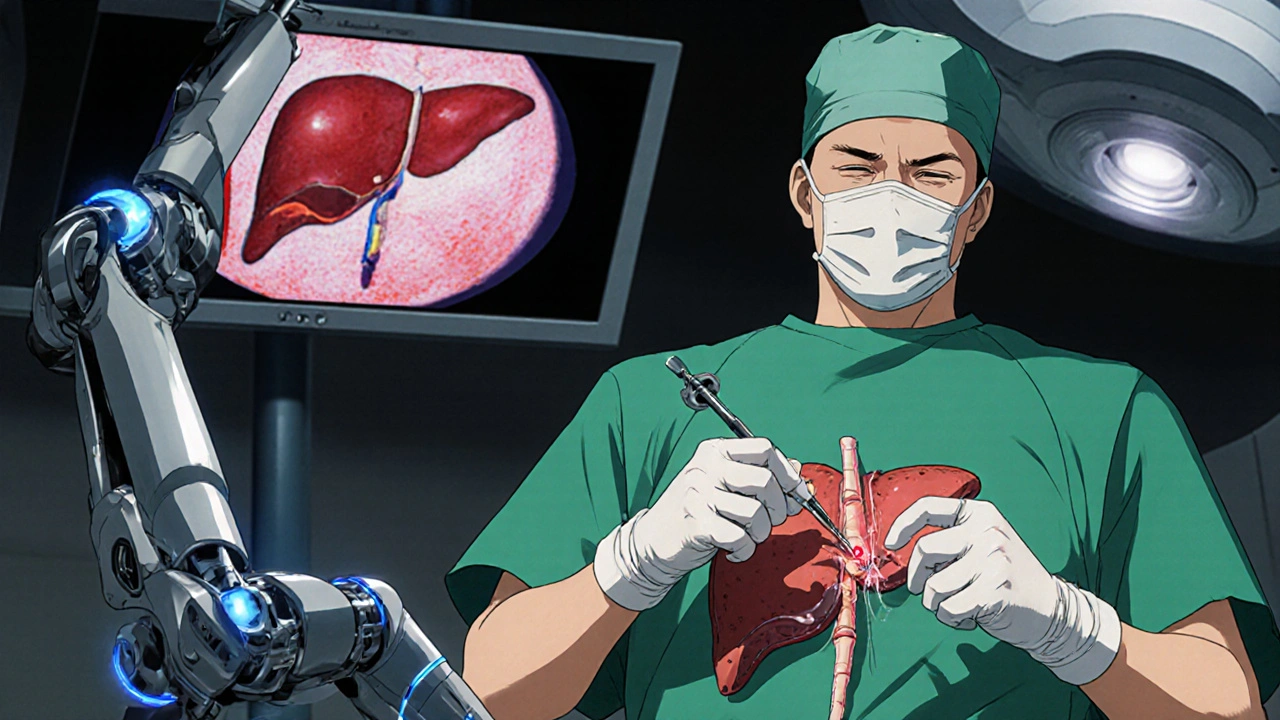Liver Cancer Surgery Candidacy Assessment Tool
Surgical Eligibility Assessment
This tool helps determine if you might be a candidate for liver cancer surgery based on your liver function, tumor characteristics, and general health. Results should always be discussed with your healthcare team.
Liver Function Assessment
Tumor Characteristics
General Health
Liver cancer is a malignant tumor that starts in the liver, most often as hepatocellular carcinoma (HCC) or intra‑hepatic cholangiocarcinoma. When it comes to liver cancer surgery, doctors weigh the chance of removing the disease against the risk of harming a vital organ. This article walks you through why surgery matters, which operations are available, how patients are selected, and where the field is heading.
Why Surgery Still Holds a Central Role
Even with breakthroughs in targeted drugs and immunotherapy, removing the tumor remains the only curative option for many patients. Surgical removal eliminates the disease bulk, reduces the source of circulating tumor cells, and often restores liver function that was compromised by the tumor’s growth.
Guidelines from major oncology societies (e.g., EASL, NCCN) list surgery as the first‑line treatment for early‑stage HCC when the tumor is resectable and the patient has adequate liver reserve. In practice, about 30‑40 % of newly diagnosed liver‑cancer patients meet these criteria.
Understanding the Main Surgical Options
- Hepatic resection (or liver‑sparing surgery) removes the tumor‑bearing segment while preserving as much healthy tissue as possible.
- Liver transplantation replaces the entire diseased organ with a donor graft, offering a chance for cure even when the tumor is beyond resection limits.
- Local ablative techniques such as radiofrequency ablation (RFA) or microwave ablation destroy tumor cells using heat.
- Adjunct procedures like portal vein embolization (PVE) boost future liver volume before a major resection.
Hepatic Resection: The Workhorse
Hepatic resection is performed either through a traditional open incision or via minimally invasive laparoscopy/robotic platforms. The choice depends on tumor location, size, and surgeon experience.
Key outcomes:
- Median 5‑year overall survival of 50‑70 % for solitary tumors ≤5 cm.
- Post‑operative liver failure rates of 3‑10 % in patients with Child‑Pugh A liver function.
- Recurrence within two years in roughly 40 % of cases, underscoring the need for close surveillance.
Liver Transplantation: When the Whole Organ Must Go
Transplantation is reserved for patients who meet the Milan criteria: a single tumor ≤5 cm or up to three tumors each ≤3 cm, with no vascular invasion. These strict limits keep post‑transplant recurrence low (about 15 % at five years).
Advantages include removal of both tumor and the cirrhotic background, which dramatically lowers the risk of new primary tumors. However, donor shortage and lifelong immunosuppression are major drawbacks.
Local Ablation and Adjuncts
For patients who cannot tolerate major surgery, percutaneous ablation offers a minimally invasive alternative. RFA achieves 2‑year disease‑free survival of 45‑55 % for lesions ≤3 cm. When combined with transarterial chemoembolization (TACE), outcomes improve further, especially in borderline candidates for resection.
Portal vein embolization, performed a week before resection, can enlarge the future liver remnant by 10‑20 %, turning an otherwise unsafe operation into a feasible one.

How Doctors Decide Who Gets Surgery
Selection hinges on three pillars:
- Liver function: Measured by Child‑Pugh score and indocyanine‑green clearance. Only patients with Child‑Pugh A or well‑compensated B are considered.
- Tumor burden: Size, number, and vascular invasion are evaluated via contrast‑enhanced MRI or multiphase CT scans.
- General health: Cardiopulmonary fitness, performance status (ECOG), and comorbidities affect operative risk.
Biomarker alpha‑fetoprotein (AFP) is used to track disease activity; rising AFP after surgery often signals early recurrence.
Risks, Recovery, and Follow‑up
Major complications include bleeding, bile leakage, and infection. Enhanced recovery after surgery (ERAS) protocols have cut hospital stays from 10 days to 5‑7 days for laparoscopic resections.
Post‑operative surveillance typically involves:
- CT or MRI every 3‑6 months for the first two years.
- AFP measurement at each visit.
- Consideration of adjuvant therapy (e.g., sorafenib) for high‑risk pathology.
Integrating Surgery with Systemic Therapies
Newer agents such as atezolizumab plus bevacizumab have shifted the treatment landscape for advanced disease. In some centers, neoadjuvant immunotherapy is being trialed to shrink tumors before resection, showing promising pathological response rates of 20‑30 %.
Conversely, adjuvant immunotherapy after resection is under investigation in several phase III trials, aiming to lower the high recurrence rate seen after curative surgery.
Future Directions: Robotics, AI, and Personalized Surgery
Robotic platforms now allow precise segmentectomy with 3‑D imaging guidance, reducing blood loss and improving margin control. Artificial‑intelligence algorithms can predict post‑operative liver failure by integrating imaging radiomics with laboratory data, helping surgeons plan safer resections.
Personalized 3‑D printed liver models are being used pre‑operatively to rehearse complex resections, especially when tumors sit near major vessels.

Key Takeaways
- Surgery remains the only curative option for early‑stage liver cancer.
- Hepatic resection suits solitary, well‑located tumors; transplantation is best for patients within Milan criteria.
- Proper patient selection-based on liver function, tumor characteristics, and overall health-is crucial.
- Minimally invasive and robotic techniques are expanding the pool of operable patients.
- Combining surgery with systemic or locoregional therapies improves long‑term survival.
Frequently Asked Questions
Can all liver cancer patients undergo surgery?
No. Only patients with adequate liver reserve (usually Child‑Pugh A), tumors that are resectable or meet transplant criteria, and acceptable overall health are considered surgical candidates.
What’s the difference between resection and transplantation?
Resection removes just the tumor‑bearing part of the liver, preserving the native organ. Transplantation replaces the whole liver, removing both tumor and cirrhotic tissue, but requires a donor organ and lifelong immunosuppression.
How long is recovery after a laparoscopic liver resection?
Most patients leave the hospital in 5‑7 days and return to normal activities within 4‑6 weeks, depending on age and overall fitness.
Is ablation as effective as surgery?
Ablation works well for small tumors (≤3 cm) and offers similar short‑term control, but long‑term survival is generally lower than for surgical resection in comparable patients.
Will my surgeon use robots for my operation?
Robotic assistance is increasingly common for complex, segment‑specific resections, but the choice depends on the hospital’s equipment and the surgeon’s expertise.
Comparison of Major Surgical Approaches
| Attribute | Hepatic Resection | Liver Transplantation | Local Ablation (RFA/MW) |
|---|---|---|---|
| Ideal tumor size | ≤5 cm (single) or up to 3 lesions ≤3 cm | Any size within Milan criteria | ≤3 cm (best results) |
| Eligibility based on liver function | Child‑Pugh A or well‑compensated B | Same, plus underlying cirrhosis acceptable | Can be performed in cirrhosis |
| 5‑year overall survival | 50‑70 % | 65‑80 % (if within criteria) | 45‑55 % |
| Invasiveness | Open or minimally invasive surgery | Major transplant surgery, ICU stay | Percutaneous, outpatient |
| Recurrence risk | ~40 % within 2 years | ~15 % within 5 years | ~30‑35 % within 2 years |
Next Steps for Anyone Facing Liver Cancer
- Ask for a multidisciplinary tumor board review - surgeons, hepatologists, radiologists, and oncologists should weigh in.
- Get a high‑resolution MRI or multiphase CT to define tumor extent and liver anatomy.
- Have liver function tested (Child‑Pugh, MELD, ICG clearance) to see if you can tolerate surgery.
- Discuss all surgical options, including the possibility of portal vein embolization to enlarge the future liver remnant.
- Plan post‑operative surveillance early - set up imaging and AFP checks before you leave the clinic.

Rajesh Singh
October 18, 2025 AT 17:06It's appalling how many patients are brushed off because their liver function isn’t perfect, yet we have the technology to push boundaries. The moral duty of surgeons is to fight for every viable candidate, not hide behind outdated criteria. With robotic precision and AI predictions, we can safely expand the pool of operable patients. Ignoring these advances feels like a betrayal of the very patients we vowed to heal.
Albert Fernàndez Chacón
October 18, 2025 AT 18:06From a clinical standpoint, the data you laid out aligns well with current NCCN guidelines. The survival stats for resection versus transplantation are compelling, especially when you factor in portal vein embolization outcomes. It’s a solid reminder that multidisciplinary discussion remains the cornerstone of optimal care.
Drew Waggoner
October 18, 2025 AT 19:06The cold statistics hide the human toll of liver surgery.
Mike Hamilton
October 18, 2025 AT 20:06Hey folks, i think its important to look at the cultural context of how we decide on surgery. People from different backgrounds may have diffrent views on organ donation and transplants. Also, the philosophy behind "curative intent" can vary, but the goal stays the same: to give patients a chance at life.
Liberty Moneybomb
October 18, 2025 AT 21:06Hold on a minute-what if the push for more aggressive surgery is just a way for big hospitals to boost their bottom line? I keep hearing whispers about pharma and device companies influencing guidelines behind the scenes. It feels like a grand experiment on patients, masked as progress. Are we truly seeing better outcomes, or are we being fed a sanitized narrative?
Brian Van Horne
October 18, 2025 AT 22:06Statistically speaking, minimally invasive techniques have demonstrably reduced hospital stays. In practice, this translates to quicker returns to daily life.
Karla Johnson
October 18, 2025 AT 23:06When evaluating the landscape of liver cancer surgery, one must first acknowledge the sheer complexity of hepatic anatomy, which is a marvel of biological engineering that demands a surgeon’s utmost respect and meticulous planning. The evolution from open laparotomy to laparoscopic and robotic platforms reflects not only technological advancement but also a paradigm shift in how we prioritize patient recovery and quality of life. It is essential to understand that resection outcomes are heavily influenced by pre‑operative liver functional reserve, often quantified by Child‑Pugh and MELD scores, which serve as gatekeepers to surgical eligibility. Moreover, the integration of portal vein embolization has transformed previously unresectable tumors into candidates for curative intent, effectively expanding the surgical horizon. While transplantation offers a definitive cure for those meeting Milan criteria, its scarcity underscores the need for alternative curative approaches, and here, ablative therapies such as RFA and microwave ablation fill a vital niche for lesions under three centimeters. The literature consistently demonstrates that five‑year overall survival after resection hovers between 50 and 70 percent, yet recurrence remains a formidable adversary, occurring in roughly 40 percent of patients within two years, which mandates a rigorous surveillance protocol. Additionally, the advent of neoadjuvant immunotherapy trials is beginning to blur the lines between systemic and surgical treatment, potentially down‑staging tumors to resectable status and improving pathological response rates. It is also worth noting that postoperative care has been revolutionized by Enhanced Recovery After Surgery (ERAS) pathways, which have cut length of stay and complications, fostering a smoother transition back to normalcy. In essence, the decision matrix for liver cancer surgery is a multifaceted construct that balances tumor biology, liver function, patient comorbidities, and evolving therapeutic modalities, all while keeping the patient’s perspective at the forefront.
Janet Morales
October 19, 2025 AT 00:06Sure, you can throw all that jargon around, but at the end of the day the real question is whether any of this actually *helps* the average Joe who can’t afford endless scans and follow‑ups. The system keeps feeding us data while patients drown in appointments.